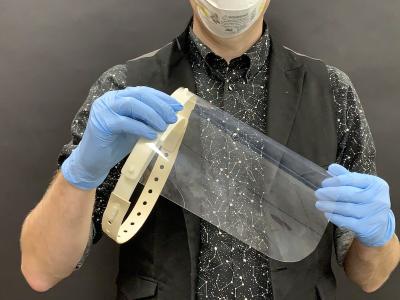University, Manufacturer Collaboration Yields COVID-19 Face Shields
Penn State Behrend teams with Port Erie Plastics, others to help offset medical personal protective equipment shortages
According to projections by the U.S. Department of Health and Human Services, the country could potentially burn through some 3.5 billion medical face masks — of both the surgical and N95 respirator variety — in the ongoing battle against the novel coronavirus. The total number of masks in the national strategic stockpile currently? A whopping 40 million — or one percent — of those needed.
The national strategic stockpile, created during President George W. Bush's second term to prepare for influenza pandemic, was greatly depleted during the response to the 2009 H1N1 pandemic — and perplexingly never replenished, according to an article published in the New York Times. As for the day-to-day supply chain of personal protective medical equipment? That became majorly derailed after China — producer of 80 percent of medical face masks — dealt with the height of their COVID-19 outbreak and consequently restricted exports in January. Other countries such as Germany, France, Taiwan, and India followed suit.
This has left domestic companies scrambling to make up the difference, a feat that may be impossible at this late juncture. However, there are those striving locally to make whatever difference they can. Penn State Behrend recently partnered with Cleveland-based Case Western Reserve University and Nottingham Spirk Design on a concept for COVID-19 face shields, with manufacturers throughout Northwest Pennsylvania and Northeast Ohio teaming in production of components.
Medical face shields are transparent plastic barriers that safeguard wearers against splashes, sprays, and spatters. Compared to other facial and optical protection methods such as masks and goggles, they're more comfortable and user-friendly, resisting fogging and allowing patients to hear care providers and interpret nonverbal facial communication more clearly. They are also relatively cheap to produce and easily disinfected (such as with an autoclave, a high-pressure, high-temperature sterilization chamger) and thus reusable. In tandem with other protection equipment, they are very effective in preventing the spread of infection.
Jason Williams, an assistant professor of plastics engineering at Behrend, teamed with Case's Ian Charnas and Spirk's Bill Rabbitt in the development of the shields, with assistance from Cleveland's University Hospitals and MAGNET manufacturing advocacy group. The final product, called White Label Face Shields, will be capable of being manufactured at a clip of tens of thousands a day in larger set ups (all the info is available on the White Label website for manufacturers to adapt it to their lines).
Five regional companies are collaborating in production locally, with an output of about 5,000 face shields a day:
- Port Erie Plastics (Erie): mold and mold frames
- Munot Plastics (Erie): shields
- Bliley Technologies (Erie): logistics and distribution
- R.C. Musson Rubber Co. (Akron, Ohio): rubber straps
- Die Cut Products (Cleveland): additional shields
Williams lauded the swiftness and coordination of the effort: "We put all of this together in a week. We were able to move quickly because of our relationships with the manufacturing community and with ECGRA, which has shown a consistent commitment to seeking and supporting projects that move Erie forward." ECGRA previously awarded a $6,700 grant to accelerate the project.
Matt Swanseger, a Penn State Behrend alumnus, is immensely proud of his more left-brained counterparts. He can be reached at mswanseger@eriereader.com


.png)
